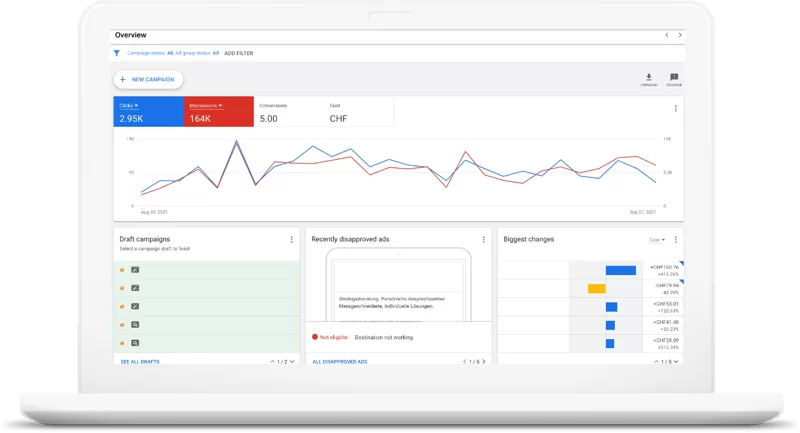How to Set Up a Google Ads Campaign
Google Ads is a powerful online advertising platform that allows businesses to reach their target audience through paid search, display, and video ads. Setting up a Google Ads campaign can be a highly effective way to drive traffic, generate leads, and increase sales. Here’s a step-by-step guide on how to set up a Google Ads campaign:

Table of Contents:
- Keyword Research
- Account Creation
- Campaign Creation
- Ad Group Creation
- Ad Creation
- Setting Budget and Bidding
- Choosing Keywords
- Ad Extensions
- Review and Launch
Let’s get started:

1. Keyword Research
Understand Your Audience:
Before creating your Google Ads campaign, it’s crucial to understand your target audience. Research their interests, behaviors, and preferences to identify the keywords they are likely to use when searching for products or services related to your business.
Before you start selecting keywords for your Google Ads campaign, it’s crucial to have a clear understanding of your target audience. Consider the following factors:
- Demographics: Who are your ideal customers? What is their age, gender, location, and income level?
- Behavior: How do they typically search for products or services online? What devices do they use?
- Interests: What are their hobbies, interests, and preferences? What problems are they trying to solve?
- Buyer Persona: Develop a detailed buyer persona that represents your ideal customer. This persona should guide your keyword choices.
Keyword Planner
Google offers a powerful tool called the “Keyword Planner” that can help you identify relevant keywords for your campaign. Here’s how to use it effectively:
a. Access the Keyword Planner
- Log in to your Google Ads account.
- Click on “Tools & Settings” in the top right corner.
- Under “Planning,” select “Keyword Planner.”
b. Discover New Keywords
- Click on “Discover new keywords.”
- Enter words or phrases relevant to your business, products, or services.
- The tool will provide a list of related keywords, along with data on their average monthly search volumes, competition levels, and suggested bid amounts.
c. Analyze Keyword Data
- Pay attention to keyword search volume: This indicates how often users search for a particular keyword on Google.
- Consider keyword competition: High competition keywords may have a higher cost per click (CPC), while low competition keywords could be more affordable.
- Suggested bids: These provide estimates of how much you might need to bid to compete for a keyword.
Keyword Match Types
Google Ads allows you to specify the match type for each keyword. Understanding these match types is essential:
– Broad Match:
- Ads may show for synonyms, related searches, and misspellings.
- Use broad match keywords for broader reach, but be prepared for less precise targeting.
– Broad Match Modifier:
- Specify certain words that must be included in user searches for your ad to appear.
- Use “+” before keywords to indicate that they are essential within the search query.
– Phrase Match:
- Ads will display when users search for the exact phrase, including words before or after it.
- Enclose your keyword in quotation marks to set it as a phrase match.
– Exact Match:
- Your ad will appear when users search for the exact keyword or close variants.
- Enclose your keyword in brackets, like [keyword], to set it as an exact match.
– Negative Keywords:
- Exclude keywords that are irrelevant to your campaign to avoid wasted spend. For instance, if you sell new laptops, you might want to exclude “used laptops.”
Competitive Research
Check out what keywords your competitors are targeting. Tools like SEMrush and Ahrefs can provide insights into your competitors’ paid search strategies. Identify which keywords are driving results for them and consider including similar keywords in your campaign.
Long-Tail Keywords
Don’t forget to include long-tail keywords in your campaign. These are longer, more specific keyword phrases that often have lower competition and higher conversion rates. Long-tail keywords can be especially effective for niche products or services.
Keyword Grouping
Group related keywords together within the same ad group. This helps ensure that your ads are highly relevant to the user’s search query, which can improve click-through rates (CTR) and quality scores.
Keyword research is the foundation of a successful Google Ads campaign. By understanding your audience, using the Keyword Planner effectively, choosing appropriate match types, conducting competitive research, and considering long-tail keywords, you can build a strong keyword list that maximizes your campaign’s reach and relevance.
Keyword Planner:
Use Google’s Keyword Planner tool to discover relevant keywords. This tool provides insights into keyword search volume, competition, and suggested bid amounts.
2. Account Creation
Sign Up:
If you don’t have a Google Ads account, sign up for one using your Google account credentials. If you already have an account, log in.
3. Campaign Creation
Create a New Campaign:
Click on “Campaigns” and then “+ New Campaign” to start a new campaign.
Choose a Campaign Goal:
Select the campaign goal that aligns with your business objectives. Common goals include website traffic, leads, sales, or brand awareness.
Choose a Campaign Type:
Select the campaign type based on your objectives. The most common types are Search, Display, Video, and Shopping.
4. Ad Group Creation
Create an Ad Group:
Within your campaign, create ad groups that focus on specific themes or product categories. For example, if you sell clothing, create ad groups for “Men’s Shirts” and “Women’s Dresses.”
Choose Keywords:
Add the keywords you researched in step 1 to each ad group. These keywords will trigger your ads when users search for them.
5. Ad Creation
Create Compelling Ads:
Craft persuasive ad copy that speaks to your audience’s needs and encourages them to take action. Each ad group should have multiple ads with different messaging to test what works best.
Add Relevant Landing Pages:
Link each ad to a relevant landing page on your website. Ensure that the landing page provides a seamless user experience and aligns with the ad’s message.
6. Setting Budget and Bidding
Set a Daily Budget:
Define your daily budget to control how much you’re willing to spend each day on the campaign.
Choose a Bidding Strategy:
Select a bidding strategy that aligns with your goals, such as maximizing clicks, conversions, or target return on ad spend (ROAS).
7. Choosing Keywords
Keyword Match Types:
Specify the match type for your keywords. Options include broad match, broad match modifier, phrase match, and exact match. Each type controls how closely a user’s search must match your keyword for your ad to appear.
8. Ad Extensions
Use Ad Extensions:
Enhance your ads with ad extensions like site link extensions, callout extensions, and structured snippet extensions. These provide additional information and encourage clicks.
9. Review and Launch
Review Your Campaign:
Before launching your campaign, carefully review all settings, ad copy, and keywords to ensure everything is in order.
Launch Your Campaign:
Click “Save” or “Launch” to activate your campaign. Google Ads will undergo a review process before your ads start appearing to users.
Monitor and Optimize:
After launching your campaign, regularly monitor its performance. Adjust bids, add negative keywords, and refine ad copy based on data to optimize results.
Setting up a Google Ads campaign requires careful planning and ongoing management. By conducting thorough keyword research, creating compelling ads, and monitoring performance, you can create campaigns that effectively reach your target audience and achieve your business objectives. Remember that successful Google Ads campaigns often require ongoing optimization to maximize their impact and return on investment.






